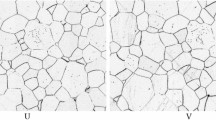Abstract
Characterizing a material’s microstructure, especially as it relates to the manufacturing processes used to fabricate it, is of great interest to engineers and researchers. In recent years, state-of-the-art imaging techniques have been able to yield a plethora of high resolution 3D data that can be used to study materials at various length scales. This 3D data is usually organized as stacked serial sections of 2D images and almost always requires some combination of enhancement and segmentation (the process of separating an image into subsets), in order to extract meaningful information. To aid in this process, ModLayer was created as a MATLAB® executable. ModLayer is an interactive graphical user interface that seeks to remove the burden of import/export redundancies when interacting with 3D data in MATLAB during visualization, modification, or segmentation through manual drawing across image stacks. The utility of ModLayer is demonstrated here through three case studies; (1) classifying regions of damage with in-situ time lapse X-ray micro-computed tomography (\(\mu \)-CT) of a glass fiber reinforced polypropylene (GFRP), (2) correcting multi-class segmentation errors in segmented X-ray \(\mu \)-CT images of a GRFP composite, and (3) capturing features of interest within in-situ 3D X-ray \(\mu \)-CT images during fatigue crack growth experiments of aluminum 7050. Overall, this tool is especially useful to engineers and researchers interested in correcting—within MATLAB—automated segmentation of noisy 3D images which can yield erroneous microstructural features in segmentation procedures.





Similar content being viewed by others
References
Landis EN, Keane DT (2010) X-ray microtomography. Mater Charact 61(12):1305–1316. https://doi.org/10.1016/j.matchar.2010.09.012
Burnett TL, McDonald SA, Gholinia A, Geurts R, Janus M, Slater T, Haigh SJ, Ornek C, Almuaili F, Engelberg DL, Thompson GE, Withers PJ (2014) Correlative tomography. Sci Rep 4:1–6. https://doi.org/10.1038/srep04711
Russ JC, Neal FB (2016) The image processing handbook. CRC Press, Boca Raton. https://doi.org/10.1201/b18983
Shi J, Malik J (2000) Normalized cuts and image segmentation part of the electrical and computer engineering commons recommended citation normalized cuts and image segmentation normalized cuts and image segmentation. IEEE Trans Pattern Anal Mach Intell 22(8):888–905. https://doi.org/10.1109/34.868688
Vaithiyanathan V, Rajappa U (2013) A review on clustering techniques in image segmentation. Int J Appl Eng Res 8(20 SPEC. ISSUE):2685–2688
Sosa JM, Huber DE, Welk B, Fraser HL (2014) Development and application of MIPAR: a novel software package for two- and three-dimensional microstructural characterization. Integr Mater Manuf Innov 3(1):1–18. https://doi.org/10.1186/2193-9772-3-10
Solomon C, Breckon T (2011) Fundamentals of digital image processing: a practical approach with examples in Matlab. Wiley, Hoboken
Hanhan I, Agyei R, Xiao X, Sangid MD (2019) Comparing non-destructive 3D X-ray computed tomography with destructive optical microscopy for microstructural characterization of fiber reinforced composites. Compos Sci Technol 184:107843. https://doi.org/10.1016/j.compscitech.2019.107843
Abràmoff MD, Magalhães PJ, Ram SJ (2004) Image processing with ImageJ. Biophotonics Int 11(7):36–42
Maire E, Withers PJ (2014) Quantitative X-ray tomography. Int Mater Rev 59(1):1–43. https://doi.org/10.1179/1743280413y.0000000023
Wang Y, Mikkelsen LP, Pyka G, Withers PJ (2018) Time-lapse helical X-ray computed tomography (CT) study of tensile fatigue damage formation in composites for wind turbine blades. Materials. https://doi.org/10.3390/ma11112340
Scott AE, Mavrogordato M, Wright P, Sinclair I, Spearing SM (2011) In situ fibre fracture measurement in carbon-epoxy laminates using high resolution computed tomography. Compos Sci Technol 71(12):1471–1477. https://doi.org/10.1016/j.compscitech.2011.06.004
Patterson BM, Cordes NL, Henderson K, Williams JJ, Stannard T, Singh SS, Ovejero AR, Xiao X, Robinson M, Chawla N (2015) In situ X-ray synchrotron tomographic imaging during the compression of hyper-elastic polymeric materials. J Mater Sci 51(1):171–187. https://doi.org/10.1007/s10853-015-9355-8
Rolland H, Saintier N, Robert G (2016) Damage mechanisms in short glass fibre reinforced thermoplastic during in situ microtomography tensile tests. Compos Part B Eng 90:365–377. https://doi.org/10.1016/j.compositesb.2015.12.021
McGee SH, McCullough RL (1984) Characterization of fiber orientation in short-fiber composites. J Appl Phys 55(5):1394–1403. https://doi.org/10.1063/1.333230
Mlekusch B (1999) Thermoelastic properties of short-fibre-reinforced thermoplastics. Compos Sci Technol 59(6):911–923. https://doi.org/10.1016/S0266-3538(98)00133-X
Avérous L, Quantin JC, Lafon D, Crespy A (1995) Determination of 3D fiber orientations in reinforced thermoplastics, using scanning electron microscopy. Acta Stereol 14(1):69–74. https://popups.uliege.be:443/0351-580x/index.php?id=705
Bay RS, Tucker CL (1992) Stereological measurement and error estimates for three-dimensional fiber orientation. Polym Eng Sci 32(4):240–253. https://doi.org/10.1002/pen.760320404
Sharma BN, Kijewski SA, Fifield LS, Shin Y, Tucker CL, Sangid MD (2018) Reliability in the characterization of fiber length distributions of injection molded long carbon fiber composites. Polym Compos 39(12):4594–4604. https://doi.org/10.1002/pc.24571
Sharma BN, Naragani D, Nguyen BN, Tucker CL, Sangid MD (2017) Uncertainty quantification of fiber orientation distribution measurements for long-fiber-reinforced thermoplastic composites. J Compos Mater. https://doi.org/10.1177/0021998317733533
Agyei RF, Sangid MD (2018) A supervised iterative approach to 3D microstructure reconstruction from acquired tomographic data of heterogeneous fibrous systems. Compos Struct 206(August):234–246. https://doi.org/10.1016/j.compstruct.2018.08.029
Emerson MJ, Dahl VA, Conradsen K, Mikkelsen LP, Dahl AB (2018) Statistical validation of individual fibre segmentation from tomograms and microscopy. Compos Sci Technol 160(January):208–215. https://doi.org/10.1016/j.compscitech.2018.03.027
Bowles CQ, Schijve J (1973) The role of inclusions in fatigue crack initiation in an aluminum alloy. Int J Fract 9(2):171–179. https://doi.org/10.1007/BF00041859
Carter ST, Rotella J, Agyei RF, Xiao X, Sangid MD (2018) Measuring fatigue crack deflections via cracking of constituent particles in AA7050 via in situ x-ray synchrotron-based micro-tomography. Int J Fatigue 116(May):490–504. https://doi.org/10.1016/j.ijfatigue.2018.07.005
Acknowledgements
The authors gratefully acknowledge support from the National Science Foundation CMMI MoM, Award No. 1662554. Partial support for I.H. was provided by the NSF GRFP, Award Number DGE-1333468. The discontinuous fiber composite material was provided by Dr. Alan Wedgewood of Dupont, and the AA7050 fatigue data was provided by Steve Carter. The authors also acknowledge Xianghui Xiao for assisting with data acquisition at the Advanced Photon Source, the use of which was supported by the US Department of Energy, Office of Science, Office of Basic Energy Sciences, under Contract No. DE-AC02-06CH11357.
Author information
Authors and Affiliations
Corresponding author
Ethics declarations
Conflict of interest
The authors declare that they have no conflict of interest.
Rights and permissions
About this article
Cite this article
Hanhan, I., Sangid, M.D. ModLayer: A MATLAB GUI Drawing Segmentation Tool for Visualizing and Classifying 3D Data. Integr Mater Manuf Innov 8, 468–475 (2019). https://doi.org/10.1007/s40192-019-00160-5
Received:
Accepted:
Published:
Issue Date:
DOI: https://doi.org/10.1007/s40192-019-00160-5




